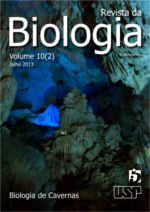In situ evaluation of the food input in the different zones of a cave: case study and methodological recommendations
DOI:
https://doi.org/10.7594/revbio.10.02.02Keywords:
Guano, Vegetal debris, Roots, Subterranean environment.Abstract
Due to the absence of light, cave environments are devoid of photosynthesizing organisms, and depend on the input of food from above ground. We compared the quantity of food available in the different zones of two caves in Serra da Canastra, MG. The amount of plant debris was highest in the entrance zone, intermediate in the twilight zone, and minimal in the dark zone. Guano was practically absent from the entrance zone, but did not present any clear pattern between the twilight and the dark zones. Therefore, plant debris seem to be more important in the entrance zone, and guano in deeper zones. We conclude with some methodological recommendations related to the quantification of food input and to statistical inference.Downloads
Download data is not yet available.
Downloads
Published
2018-04-23
Issue
Section
Artigo
License
We ensure that our journal does not retain any copyright and that these are exclusive of the author(s) of the text. In that sense, we intend to break any restrictions to the published material and to achieve more intensely our goal of communicating science.
How to Cite
Dodonov, P., Freitas, J. R. de, Tezori, R. F. F., & Bichuette, M. E. (2018). In situ evaluation of the food input in the different zones of a cave: case study and methodological recommendations. Revista Da Biologia, 10(2), 8-12. https://doi.org/10.7594/revbio.10.02.02






